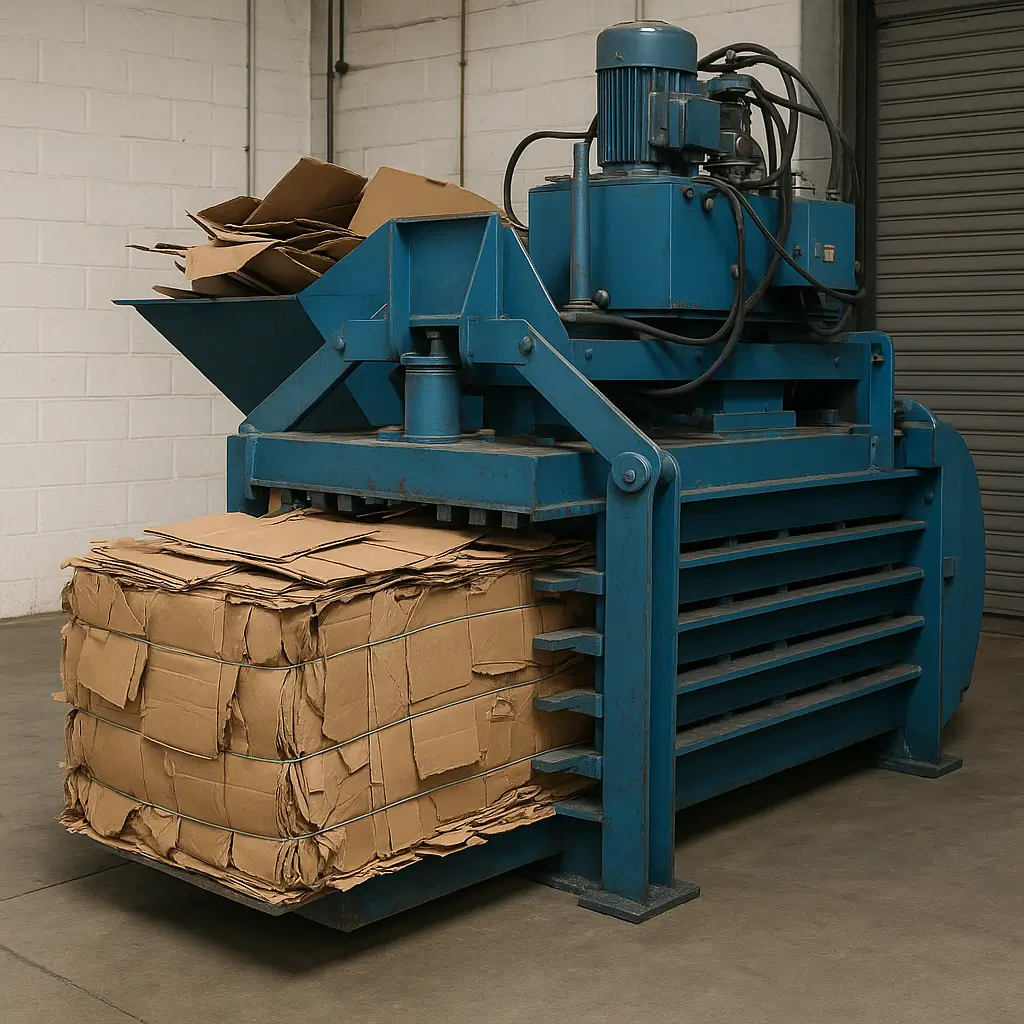Key Takeaway: Businesses and individuals can legally and profitably engage in the baling and sale of cardboard—provided they comply with property and recycling regulations, invest in proper equipment to produce mill-sized bales, and partner with licensed recyclers. Stores monetize cardboard by selling compacted bales to recycling firms, offsetting disposal costs and even earning rebates. Individuals can also earn by collecting and baling cardboard, though considerations of volume, bale specifications, and local regulations are critical.
1. Legal Considerations for Taking Cardboard Bales
1.1 Property Rights and Theft
Cardboard discarded by retailers remains the property of the store or its contracted waste carrier until formally relinquished. Removing baled cardboard without permission constitutes theft or unauthorized removal of commercial property. In New York City, for example, new legislation prohibits removal or acceptance of cardboard from licensed carters, with offenders facing fines and criminal charges. Similarly, the Business Integrity Commission emphasizes that recycling theft is a crime that undermines legitimate businesses and can lead to significant penalties, including imprisonment.
1.2 Dumpster Diving vs. Baled Material
While many jurisdictions tolerate taking loose cardboard from public bins (often deemed abandoned waste), baled cardboard is generally kept in secured areas behind stores or industrial sites. Entering private property to remove bales may constitute trespassing and theft—even if the material appears destined for recycling. Always obtain explicit permission from the property owner or recycling contractor before removing compacted bales.
1.3 Local Ordinances and Variations
Municipal codes can vary:
- Some counties ban removal of recyclable materials from collection sites, penalizing offenders only if they trespass.
- In Lincoln, Nebraska, clean cardboard is banned from landfill streams, but unauthorized removal is governed by county waste collector policies rather than city-issued fines.
- Under upcoming UK regulations, businesses must separate cardboard for collection but may sell or donate clean bales without penalty, provided they follow waste duty-of-care requirements.
Recommendation: Verify local waste and theft statutes, ensure you have property owner consent, and engage licensed waste carriers when removing or selling baled cardboard.
2. How Stores Profit from Cardboard Bales
2.1 Cost Savings on Waste Management
Uncompacted cardboard occupies substantial volume, necessitating frequent bin or roll-off container pickups. Baling reduces volume by up to 90%, allowing stores to:
- Decrease collection frequency.
- Lower hauling fees.
- Free up storage and loading-dock space.
2.2 Revenue Generation via Rebates and Sales
Many retailers invest in vertical or horizontal balers to produce mill-sized bales (typically 100 × 120 × 80 cm weighing ≥ 400 kg), qualifying for higher rebates or per-ton payments from recyclers.
- In the U.S., rated bale prices range from $70 to $120 per ton, with a national average near $95 per ton.
- In the U.K., bale values fluctuate between £50 and £150 per tonne.
2.3 Equipment ROI and Operational Efficiencies
- A mid-range vertical baler (~25-ton compression) costs $23,900 and pays back through profiteering on bale sales and waste savings in 18–24 months.
- Horizontal balers, though costlier ($31,750–$37,200), deliver higher throughput and premium bale densities that may fetch 15–22% higher prices.
By optimizing bale density and purity, stores can negotiate bulk contracts and secure stable revenue streams. For grocery chains and big-box retailers, baling is integral to lean inventory management, preventing labor costs tied to manual box breakdown and reducing safety incidents around overloaded dumpsters.
3. Individual Opportunities: Can You Get Paid for Baled Cardboard?
3.1 Earning Potential
Individuals or small operators can collect and bale cardboard from consenting businesses—warehouses, stores, or distribution centers—and deliver to recycling centers. Earnings vary by region and bale weight:
- Side Hustle Example: A U.S. entrepreneur made $500 profit from three tons of baled cardboard in a single run, netting $180 per ton before expenses.
- Scrap Yard Rates: Typically $80–$120 per ton, influenced by location, quality, and seasonal demand.
- Load-Based Payouts: Six large bales (~3–5 tons) may yield $300–$540 per pickup in 2022 rates.
3.2 Volume and Bale Specifications
To achieve profitable rates, aim for:
- “Mill-size” bales: 100 × 120 × 80 cm weighing ≥ 400 kg (≈ 880 lb).
- Minimum weekly volume: About 20 loose cubic yards to justify baler rental/purchase and collection logistics.
Smaller loose loads yield lower per-weight prices; baled material commands an approximate 30% premium due to handling efficiencies.
3.3 Equipment and Logistics
- Vertical balers suit low-to-mid volumes and retail/back-of-store environments.
- Horizontal balers support higher throughput but require greater capital and space.
- Ensure access to pallet jacks or forklifts for bale movement.
- Secure covered storage to prevent moisture contamination, which degrades bale value and may render bales unsellable.
3.4 Regulatory Compliance
Individuals must:
- Obtain permission from property owners.
- Adhere to local waste-of-care regulations.
- Work with licensed recyclers to ensure lawful transfer of property and receipt of payment.
4. Market Value and Price Fluctuations
4.1 Historical Price Trends
- U.S. bale prices ranged from $20 to $210 per ton over five years, averaging $6–$63 per 300 kg bale depending on fiber market fluctuations.
- In Europe, Madrid’s Operation Hartie disrupted gangs stealing 67,000 tons annually (€10 million worth), reflecting cardboard’s “beige gold” status.
4.2 Factors Affecting Value
- Quality and purity: Clean, uncontaminated bales earn premiums; coated, wet, or mixed materials incur penalties or rejection.
- Density: High-density (> 800 kg/m³) bales fetch up to $115 per ton, while lower-density (< 600 kg/m³) bales sell for $70 per ton.
- Moisture content: Above 12% moisture can deduct $15 per ton; below 8% can add $20 per ton.
- Market demand: E-commerce surges and seasonal packaging peaks (e.g., holidays) drive short-term price spikes.
- Location and transport costs: Urban centers command higher rates due to reduced hauling distances and concentrated supply.
5. Best Practices for Profitability
- Invest in Proper Baling Equipment Acquire a baler suited to your volume—vertical for small businesses, horizontal for large-scale operations. Ensure bale dimensions meet mill requirements to maximize rebates.
- Maintain Bale Quality Keep cardboard clean, dry, and free of non-fiber contaminants. Store bales under cover and avoid wetting to prevent fiber degradation.
- Build Relationships with Recyclers Negotiate volume-based contracts, secure favorable pricing, and ensure timely collections to avoid storage bottlenecks.
- Optimize Collection Logistics Plan routes, consolidate pickups, and minimize transport distances to reduce fuel and labor costs.
- Monitor Market Trends Track commodity price indices and local demand cycles. Time sales during high-price periods and maintain flexible storage to capitalize on opportunistic pricing.
Conclusion: Harnessing the value of cardboard bales requires understanding legal boundaries, employing the right equipment, and forging partnerships with licensed recyclers. Whether for a retailer seeking to reduce waste costs or an entrepreneur building a recycling side hustle, baled cardboard represents a legitimate revenue stream—provided best practices in bale specifications, storage, and compliance are followed.



Leave a Reply